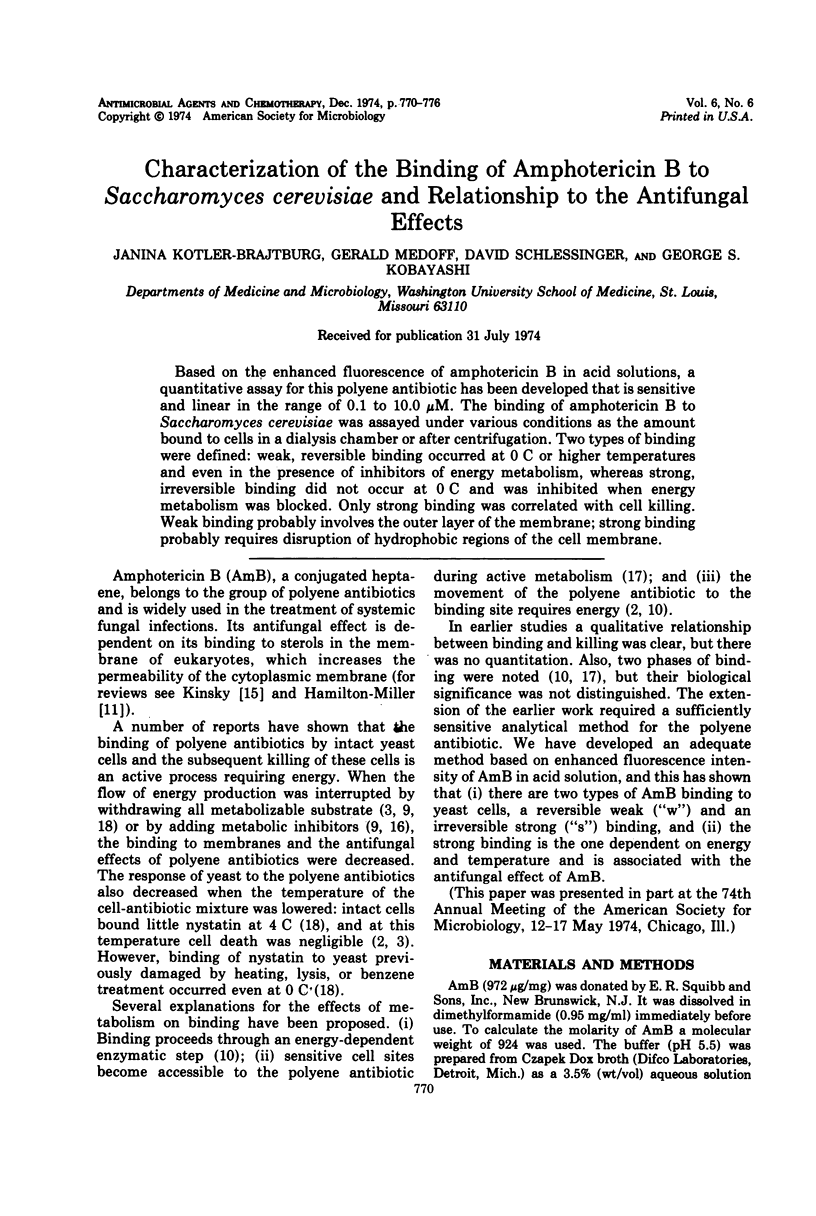Abstract
Based on the enhanced fluorescence of amphotericin B in acid solutions, a quantitative assay for this polyene antibiotic has been developed that is sensitive and linear in the range of 0.1 to 10.0 μM. The binding of amphotericin B to Saccharomyces cerevisiae was assayed under various conditions as the amount bound to cells in a dialysis chamber or after centrifugation. Two types of binding were defined: weak, reversible binding occurred at 0 C or higher temperatures and even in the presence of inhibitors of energy metabolism, whereas strong, irreversible binding did not occur at 0 C and was inhibited when energy metabolism was blocked. Only strong binding was correlated with cell killing. Weak binding probably involves the outer layer of the membrane; strong binding probably requires disruption of hydrophobic regions of the cell membrane.
Full text
PDF






Selected References
These references are in PubMed. This may not be the complete list of references from this article.
- Barousse A. P., De Bercovich C., Firmat J., Malamud E. E. Extraccion de amphotericin-B por hemodiálysis extracorpórea. Medicina (B Aires) 1971 Jan-Feb;31(1):26–30. [PubMed] [Google Scholar]
- Brandsberg J. W., French M. E. In vitro susceptibility of isolates of Aspergillus fumigatus and Sporothrix schenckii to amphotericin B. Antimicrob Agents Chemother. 1972 Nov;2(5):402–404. doi: 10.1128/aac.2.5.402. [DOI] [PMC free article] [PubMed] [Google Scholar]
- Feldman H. A., Hamilton J. D., Gutman R. A. Amphotericin B therapy in an anephric patient. Antimicrob Agents Chemother. 1973 Sep;4(3):302–305. doi: 10.1128/aac.4.3.302. [DOI] [PMC free article] [PubMed] [Google Scholar]
- GHOSH A., GHOSH J. J. ABSORPTION OF AMPHOTERICIN B BY CANDIDA ALBICANS. Ann Biochem Exp Med. 1963 Dec;23:603–610. [PubMed] [Google Scholar]
- GHOSH A., GHOSH J. J. Factors affecting the absorption of nystatin by Candida albicans. Ann Biochem Exp Med. 1963 Mar;23:101–112. [PubMed] [Google Scholar]
- Jollow D., Kellerman G. M., Linnane A. W. The biogenesis of mitochondria. 3. The lipid composition of aerobically and anaerobically grown Saccharomyces cerevisiae as related to the membrane systems of the cells. J Cell Biol. 1968 May;37(2):221–230. doi: 10.1083/jcb.37.2.221. [DOI] [PMC free article] [PubMed] [Google Scholar]
- KINSKY S. C. Alterations in the permeability of Neurospora crassa due to polyene antibiotics. J Bacteriol. 1961 Dec;82:889–897. doi: 10.1128/jb.82.6.889-897.1961. [DOI] [PMC free article] [PubMed] [Google Scholar]
- KINSKY S. C. Effect of polyene antibiotics on protoplasts of Neurospora crassa. J Bacteriol. 1962 Feb;83:351–358. doi: 10.1128/jb.83.2.351-358.1962. [DOI] [PMC free article] [PubMed] [Google Scholar]
- LAMPEN J. O., ARNOW P. M., BOROWSKA Z., LASKIN A. I. Location and role of sterol at nystatin-binding sites. J Bacteriol. 1962 Dec;84:1152–1160. doi: 10.1128/jb.84.6.1152-1160.1962. [DOI] [PMC free article] [PubMed] [Google Scholar]
- LAMPEN J. O., ARNOW P. Significance of nystatin uptake for its antifungal action. Proc Soc Exp Biol Med. 1959 Aug-Sep;101:792–797. doi: 10.3181/00379727-101-25098. [DOI] [PubMed] [Google Scholar]
- LAMPEN J. O., MORGAN E. R., SLOCUM A., ARNOW P. Absorption of nystatin by microorganisms. J Bacteriol. 1959 Aug;78:282–289. doi: 10.1128/jb.78.2.282-289.1959. [DOI] [PMC free article] [PubMed] [Google Scholar]
- LUZZATI V., HUSSON F. The structure of the liquid-crystalline phasis of lipid-water systems. J Cell Biol. 1962 Feb;12:207–219. doi: 10.1083/jcb.12.2.207. [DOI] [PMC free article] [PubMed] [Google Scholar]
- Schroeder F., Holland J. F., Bieber L. L. Fluorometric investigations of the interaction of polyene antibiotics with sterols. Biochemistry. 1972 Aug 1;11(16):3105–3111. doi: 10.1021/bi00766a026. [DOI] [PubMed] [Google Scholar]
- Schwencke J., Magaña-Schwencke N. Temperature effects on the proline transport system of Saccharomyces chevalieri. Biochim Biophys Acta. 1971 Aug 13;241(2):513–521. doi: 10.1016/0005-2736(71)90050-2. [DOI] [PubMed] [Google Scholar]
- Shadomy S., McCay J. A., Schwartz S. I. Bioassay for hamycin and amphotericin B in serum and other biological fluids. Appl Microbiol. 1969 Apr;17(4):497–503. doi: 10.1128/am.17.4.497-503.1969. [DOI] [PMC free article] [PubMed] [Google Scholar]
- de Kruijff B., Demel R. A. Polyene antibiotic-sterol interactions in membranes of Acholeplasma laidlawii cells and lecithin liposomes. 3. Molecular structure of the polyene antibiotic-cholesterol complexes. Biochim Biophys Acta. 1974 Feb 26;339(1):57–70. doi: 10.1016/0005-2736(74)90332-0. [DOI] [PubMed] [Google Scholar]
- de Kruijff B., Gerritsen W. J., Oerlemans A., van Dijck P. W., Demel R. A., van Deenen L. L. Polyene antibiotic-sterol interactions in membranes of Acholesplasma laidlawii cells and lecithin liposomes. II. Temperature dependence of the polyene antibiotic-sterol complex formation. Biochim Biophys Acta. 1974 Feb 26;339(1):44–56. doi: 10.1016/0005-2736(74)90331-9. [DOI] [PubMed] [Google Scholar]


